Expert's Rating
Pros
- Slim and sleek design
- Outstanding OLED display
- Rapid charging
- Excellent audio
Cons
- No Google Play Store or services
- Quite expensive
- Middling battery life
Our Verdict
The Huawei MatePad Pro 13.2 offers a sleek design, solid performance, an outstanding OLED display, and strong audio output. However, Huawei’s ongoing issues with Google support (there isn’t any) means you probably shouldn’t buy its latest tablet.
You have to hand Huawei credit for persistence. Despite being hobbled by severe software and component restrictions here in the West, the Chinese company continues to plug away with fresh hardware releases.
When you see what’s on offer in the Huawei MatePad Pro 13.2, you can kind of understand why. This is a sleek, powerful tablet with an outstanding super-sized display and some strong accessories.
Of course, with launch pricing starting from €999 (we’re still awaiting UK pricing, but £999 seems like a reasonable bet), you’ll be paying a premium price for such elevated hardware. This is a high-end tablet in a similar mould to the Samsung Galaxy Tab S9 Plus.
Huawei’s going to need to nail all the basics as a bare minimum if it hopes to compete at this end of the tablet market.
Design & Build
- Very big but very thin and light
- Plastic frame, glass fibre rear
- No fingerprint sensor
We’ve said it before and we’ll say it again – as awkward as Huawei’s software situation is, the company knows how to make hardware that’s both compelling and unique.
The Huawei MatePad Pro 13.2 is a huge tablet with a whopping great 13.2-inch display, yet it’s a mere 5.5mm thick and somehow only weighs around 580g.
I say “somehow”, but it’s not a huge mystery how this feat has been achieved. While this is being marketed as a Pro tablet, with many of the premium elements this entails, the Huawei MatePad Pro 13.2 is made primarily of plastic. The frame is pure plastic, while the rear uses glass fibre with a nano-scale optical finish to make it look metallic.
Huawei is one of precious few non-Apple tablet manufacturers to implement a properly secure facial recognition system
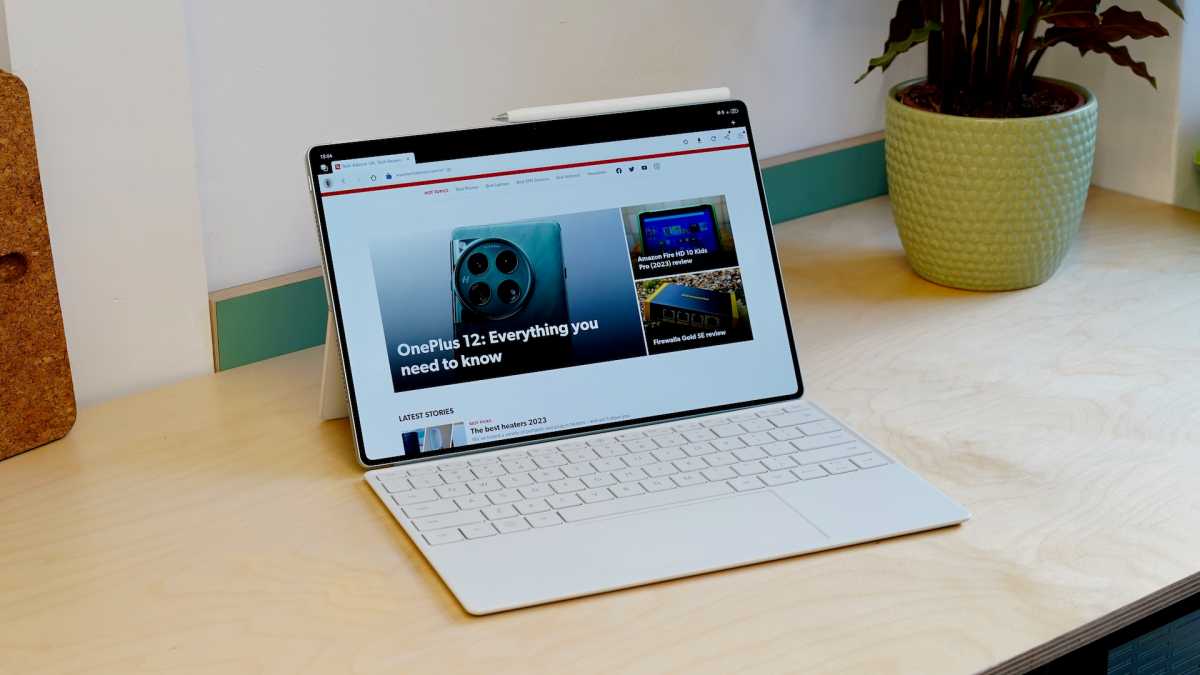
Jon Mundy / Foundry
It’s an interesting tradeoff. On the one hand, the Huawei MatePad Pro 13.2 doesn’t feel as premium as an iPad Pro, a Samsung Galaxy Tab S9 Plus, or even a Lenovo Tab P12 Pro. On the other, it’s relatively comfortable to hold for extended periods, which not all of those rivals can claim.
It would be wrong to say that Huawei has cheaped out on design here. The screen bezel is quite minimalistic for a tablet, resulting in an impressive 94% screen-to-body ratio. True, this can mean that your thumb or palm hangs over the display a little when you’re holding it, but it’s not a huge issue.
The colour options include Golden Black and Green. I was sent the latter, and it’s more of an icy mint than flat-out green as you can see.

Jon Mundy / Foundry
There’s no fingerprint sensor provision here, but that’s excusable. Huawei is one of precious few non-Apple tablet manufacturers to implement a properly secure facial recognition system using the front-facing camera in conjunction with ToF depth sensors.
It works even in poor lighting, smartly lighting up the huge display where necessary.
M-Pencil & Smart Magnetic Keyboard
- 3rd gen M-Pencil
- 10,000 levels of pressure sensitivity
- Smart Magnetic Keyboard comes in two parts
Huawei has produced its third generation M-Pencil stylus (priced at €99) and a Smart Magnetic Keyboard (€199) as part of the wider MatePad Pro 13.2 ecosystem. The former attaches to the top edge of the MatePad Pro 13.2 magnetically, where it will also charge.
It offers a suitably strong writing and drawing experience, with 10,000 levels of pressure sensitivity (up from the usual 4,096). This really manifests itself when using the pencil tool in the preinstalled Notepad or Notes app, with an impressive amount of nuance and variation possible depending on how hard you press.
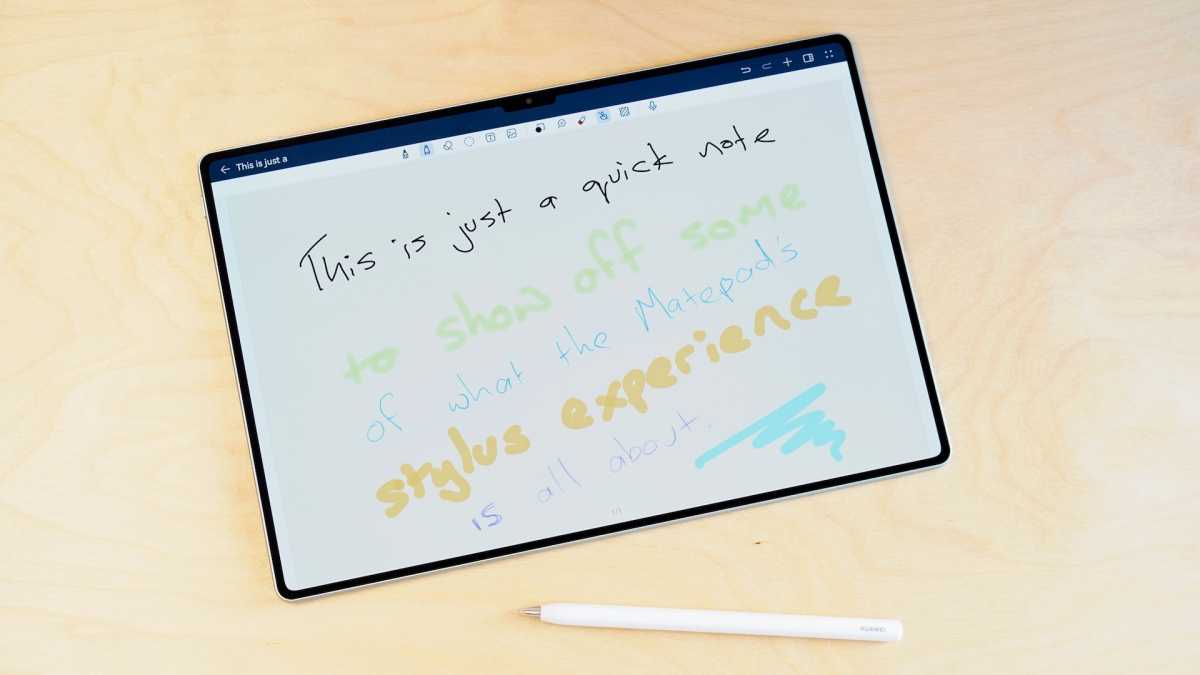
Jon Mundy / Foundry
The level of resistance on this (replaceable) tip isn’t the most pleasingly tactile to my mind. I would have liked a little a little more grippiness for something closer to the pen-and-paper experience. Huawei itself offers its PaperMatte devices if that’s a concern that you share.
Huawei’s Smart Magnetic Keyboard comes in two parts – a snap-on rear cover and kickstand for the rear of the MatePad, and a magnetic keyboard that connects to the tablet wirelessly. This feels like a slightly unwieldy approach, but when secured it provides a solid typing experience.
The keyboard mimics a laptop-like chiclet layout, comparable levels of key travel and a proper clicky touchpad so it’s really vying to be a laptop replacement. Huawei has implemented an intuitive gesture-based navigation system into that touchpad, so you won’t need to interact directly with the screen unless you wish to.
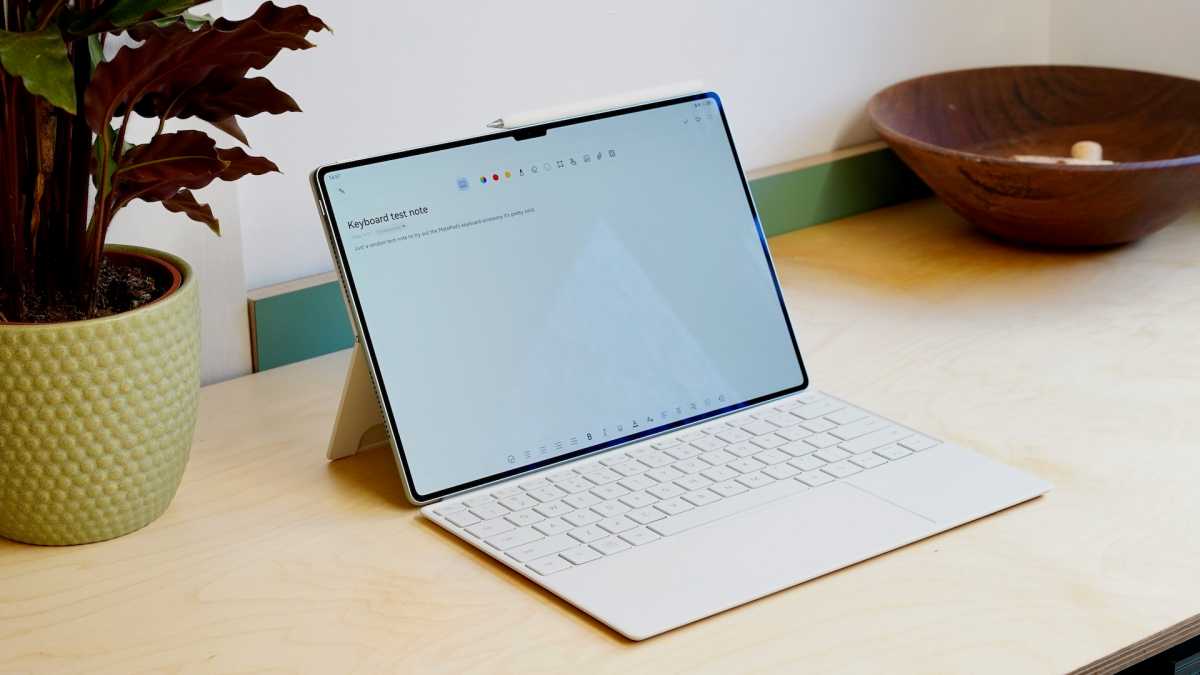
Jon Mundy / Foundry
One annoyance I found was that the keyboard didn’t automatically disconnect when I took it off, necessitating a hard disconnect via the Bluetooth toggle so that I could restore the virtual keyboard.
As is always the case with these tablet keyboards, there’s an inherent lack of rigidity that’s more flattop than laptop. You’ll need a table or some other flat surface for it to be viable as a productivity tool.
Talking of which, your favoured productivity app may not work too seamlessly with the Huawei MatePad Pro 13.2, particularly if you use Google Docs. We’ll discuss that more in the software section later.
this thing is a truly brilliant multimedia tool
Screen & Speakers
- 13.2in AMOLED
- 144Hz refresh rate
- Six speakers
The main event here is the Huawei MatePad Pro 13.2’s ginormous 13.2in OLED display.
With a 2880 x 1920 resolution (for 262ppi) and those punchy-but-not-too-punchy) OLED colours, this thing is a truly brilliant multimedia tool. Only something like the way more expensive Samsung Galaxy Tab S9 Ultra and its ridiculous 14.6in panel is able to outdo it.
Samsung’s uber-tablet can’t top the MatePad Pro 13.2 display for fluidity though. An unusually high maximum refresh rate of 144Hz seems like overkill when 120Hz is more than enough, but you won’t catch me complaining.
Nor can Samsung’s tablet hold a candle to Huawei when it comes to brightness, with the MatePad Pro 13.2 capable of scaling peaks of 1,000 nits. I recorded it hitting 600 nits with auto-brightness switched off, which is very good for a tablet.
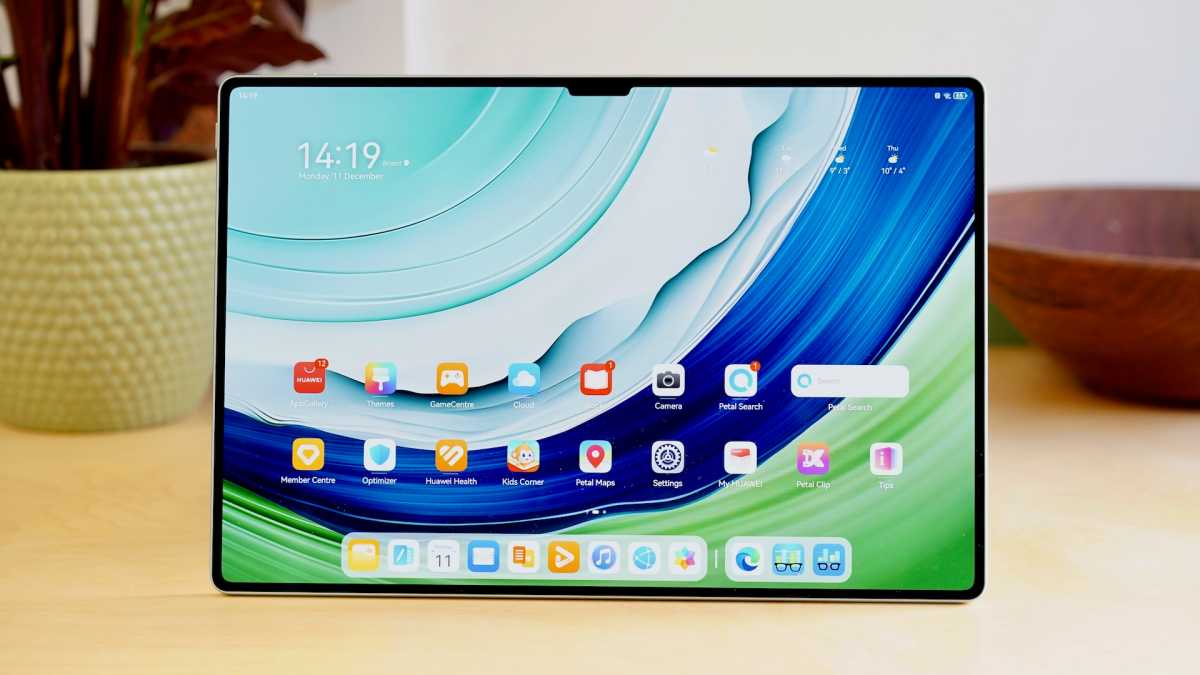
Jon Mundy / Foundry
It’s extremely colour-accurate with a gamut coverage of 99.5% sRGB against a gamut volume of 103.3% using the Normal colour mode, and a superb Delta E rating of 0.74.
Watching video content on this screen is fabulous. Or at least, it’s potentially fabulous. In practical terms, finding content to stream can prove extremely awkward.
This touches more on the software shortcomings of the MatePad Pro 13.2 (and Huawei devices in general), but even when you manage to hunt down a major service like Netflix on a third-party app store, you’ll find that it only streams at an SD resolution with no HDR.
If you can secure access to sufficiently high-quality video material, you’ll benefit from superb sound output. Huawei has packed its super-sized tablet with six speakers, producing spacious and crisp audio. It remains clear at surprisingly loud volumes, too.
Specs & Performance
- Kirin 9000S chip offers mid-range performance
- 12GB storage
- 256 or 512GB storage
The MatePad Pro 13.2 is powered by the same home-brewed Kirin 9000S chip that powered the flagship Huawei Mate 60 Pro smartphone earlier in the year.
It’s made using a rather inefficient 7nm process, but it’s certainly a capable chip. Combined with a generous 12GB of RAM, performance is fluid and hitch-free when jumping between apps and scrolling through menus. For the money, however, you might expect more.
Benchmark tests point to a CPU performance level comfortably beyond the Lenovo P12 Pro with its mid-range Snapdragon 870, but well short of the similarly priced Galaxy Tab S9 Plus with its Snapdragon 8 Gen 2. In GPU terms it falls well short of both tablets, suggesting that this isn’t a tablet for avid gamers.
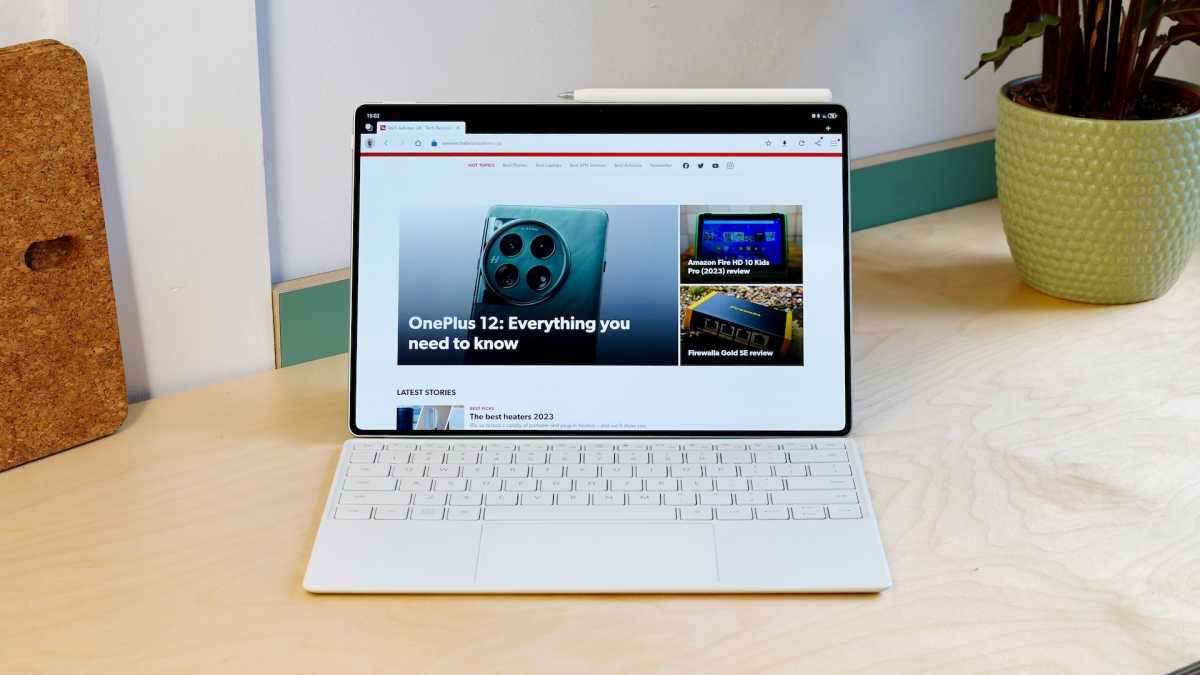
Jon Mundy / Foundry
Of course, given the ongoing situation with Huawei devices and app support, resulting in a distinct lack of access to the latest and greatest games, that last point rather goes without saying.
Even so, Huawei’s claims that the MatePad Pro 13.2 runs cool certainly proved true in my experience. I found that it was running at a comfortable temperature even after running successive GPU benchmark tests.
There’s plenty of storage on tap too, with a choice of either 256- or 512GB models.
Huawei MatePad Pro 13.2 benchmarks
Cameras
- 13Mp main camera with AF
- 8Mp ultra-wide
- 16Mp selfie cam with dToF
It’s not worth spending too much time deliberating over the camera set-up of a tablet – especially not a huge 13.2in one. Suffice to say that the Huawei MatePad Pro 13.2 goes above and beyond with its provision.
You get two sensors around back, with a 13Mp f/1.8 main camera assisted by an 8Mp ultrawide.
In the few quick snaps I took with this set-up, the MatePad Pro 13.2 proved an adequate performer. Adequate in tablet terms means ‘not totally unusable’ or ‘useful in a pinch’ on the very few occasions you’re caught without your phone.
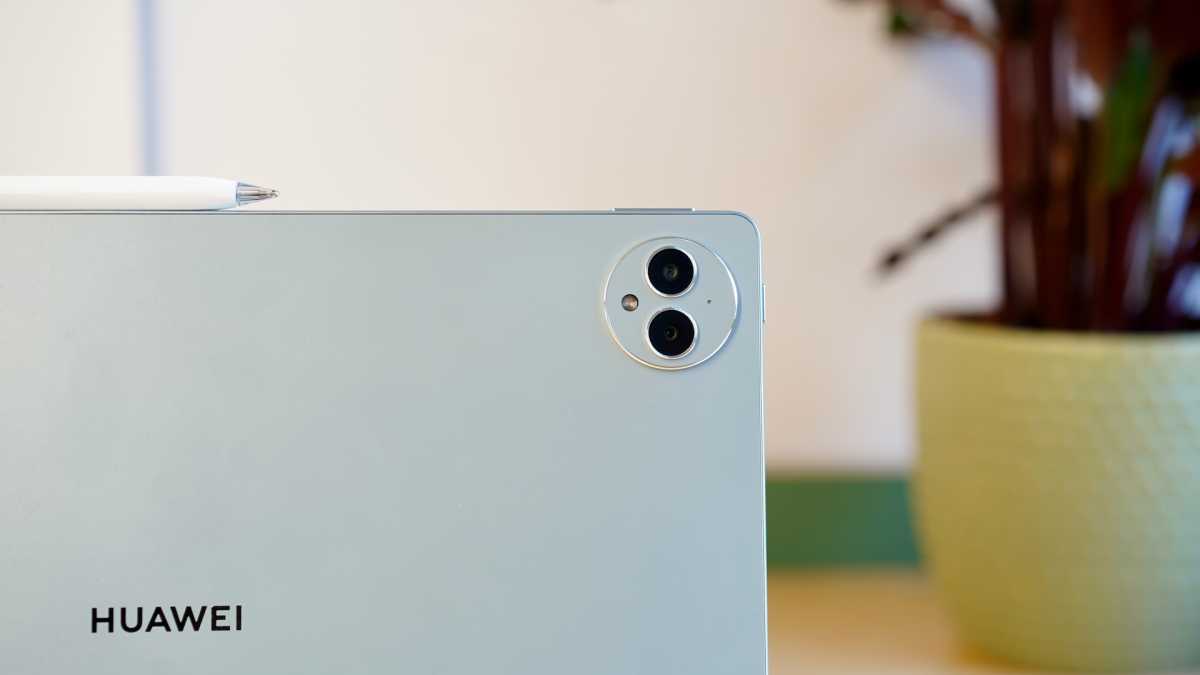
Jon Mundy / Foundry
As you’d expect, the main sensor does much better with detail, exposure and dynamic range, but you’d expect that. All in all, Huawei’s photographic expertise ensure that shots are reasonably bright and balanced, if a little processed-looking.
Probably more important on a tablet is the front camera. That’s especially the case with the Huawei MatePad Pro 13.2, as it’s the sole means of biometric authentication.
This means you’re getting a 16Mp sensor with an f/2.2 aperture and a dToF sensor. The latter judges 3D depth, meaning it can scan your face with precision for secure authentication. It also helps capture selfies with reasonable clarity, though you’ll want to opt out of those awful beautifying and weird mirror effects.
Battery Life & Charging
- Dual 5050mAh cells for 10,100mAh capacity
- Scores poorly on PCMark Work 3.0 test
- Fast 88W charger bundled in
The Huawei MatePad Pro 13.2 runs on twin 5050 mAh cells for a total capacity of 10,100mAh. Such chunky capacities are necessary with these super-sized tablets, as they typically take a bigger battery hit than their smaller or more regular-sized brothers.
A full charge will take a little over an hour. That’s outstanding within the rarified big tablet field.
Standby time is excellent, with just a few percentage points lost when left inactive for about 18 hours. However, I was particularly worried for the MatePad Pro 13.2’s stamina given its provision of such a large, bright, and fast display, as well as that relatively inefficient 7nm processor.
Sure enough, sustained usage will drain the battery fast. In the PCMark Work 3.0 battery test, which simulates a range of regular usage scenarios, the Huawei MatePad Pro 13.2 scored six hours and 45 minutes. That’s short of other supersized tablets such as the Lenovo Tab P12 Pro and the Samsung Galaxy Tab S9 Ultra.
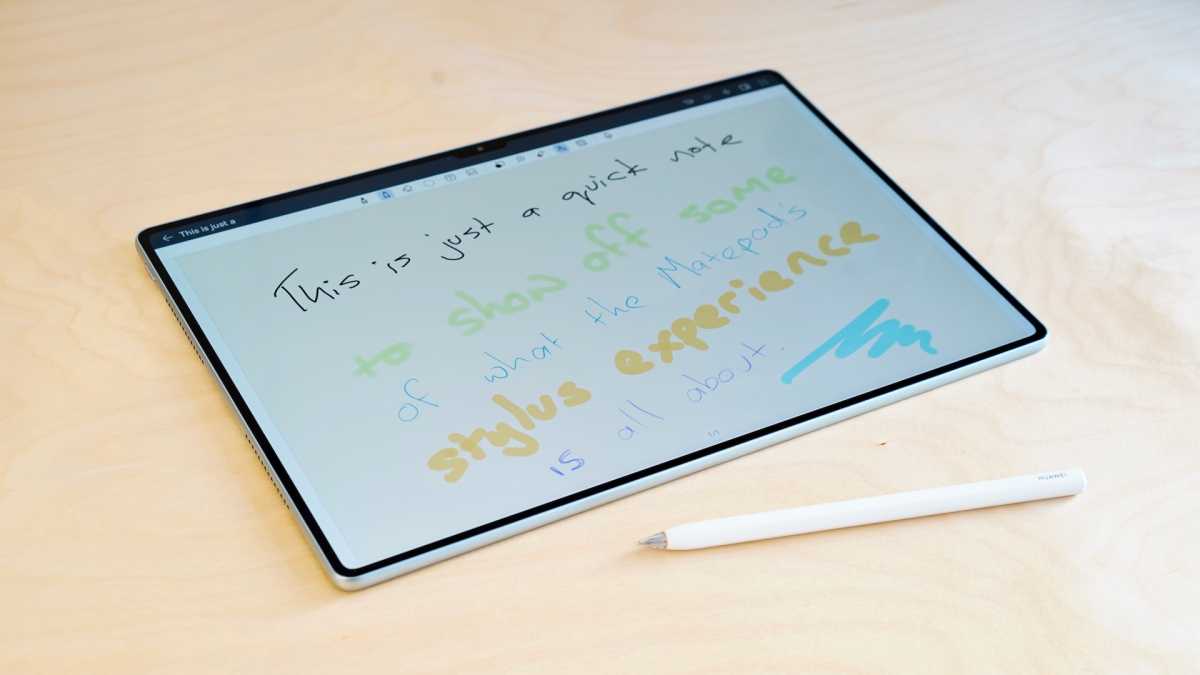
Jon Mundy / Foundry
It should be noted that I was running the MatePad at the ‘High’ 144Hz refresh rate setting, as is our wont. Sticking with the default Dynamic refresh rate – or even bumping things down to the Medium setting (which is still 120Hz) – will doubtless extend that battery life a little.
Even if you do prefer to run the MatePad Pro 13.2 flat out, Huawei has compensated with an unusually generous charging provision. It supplies an impressive 88W charger in the box.
Using this accessory, I recorded the MatePad 13.2 as being able to get from empty to 63% in just 30 minutes. A full charge will take a little over an hour. That’s outstanding within the rarified big tablet field.
Software & Apps
- Harmony OS 4.0 reasonably clean and fluid
- No Google Play Store or apps
- AppGallery and Petal Search instead
I’ve referenced Huawei’s software woes a few times already, and that’s because it permeates the whole MatePad Pro 13.2 experience.
Huawei’s bespoke Harmony OS 4.0 takes the bare bones of open source Android and builds its own custom OS on top. This is out of necessity more than choice. Thanks to US sanctions, there’s no access to Google’s services here.
This is about more than just a few preinstalled apps. It means that the MatePad Pro 13.2 can’t access the Google Play Store, meaning you have to source your apps from Huawei’s own severely limited AppGallery, or from a whole host of third-party app stores via Huawei’s Petal Search tool.
Huawei has made a number of claims about the ease and safety of sourcing apps in this way, but there’s no escaping that it’s well below the standard of the regular Android experience found on rivals. It’s way clunkier, with far more hoop-jumping involved, and without the same seamless access to updates.
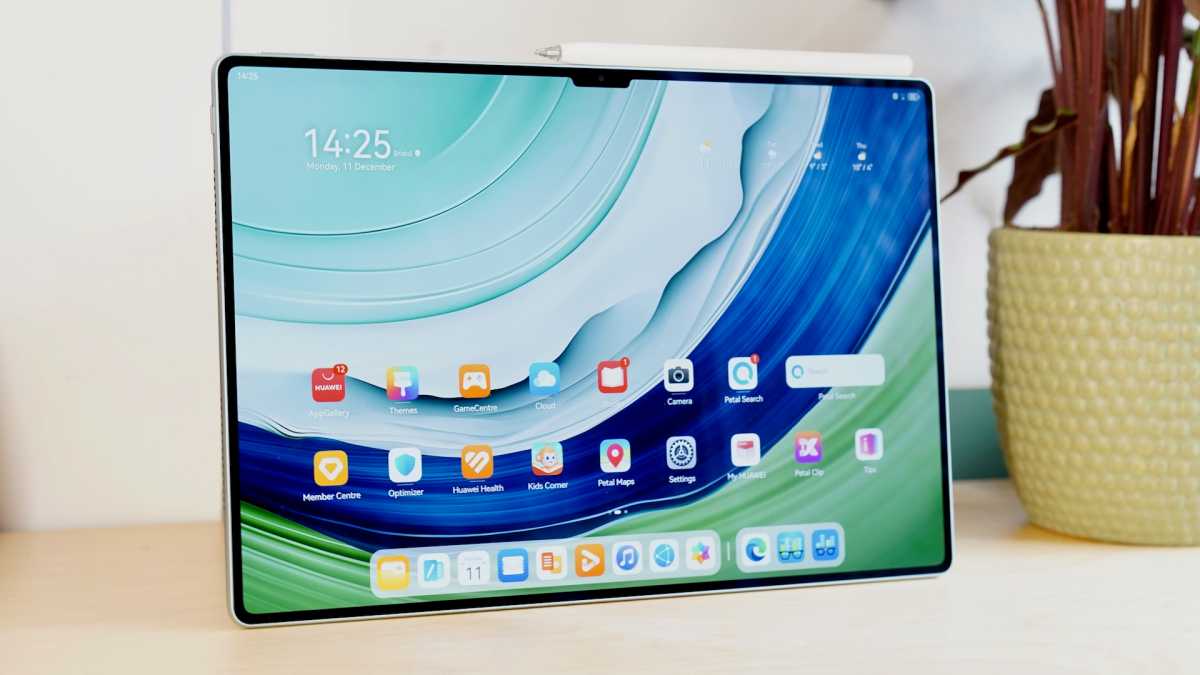
Jon Mundy / Foundry
It’s also fundamentally less secure. I’ve personally never encountered a security issue when downloading apps on a Huawei device, but the fact is that Huawei can’t vouch for the provenance of any app sourced from outside the AppGallery. It merely plays the role of gatekeeper.
Even then, many popular apps don’t play nicely with Huawei devices. As mentioned above, Netflix works, but only with the bare minimum of streaming quality.
Bear in mind, too, that the lack of Google support goes beyond mere app access. It means no easy log-ins, no Google Pay payments on websites, and inferior media casting options to smart devices.
Harmony OS 4.0 itself is pleasant enough to use, and seems less buggy than previous iterations. It’s not as stylish or intuitive as stock (or stock-ish) Android tablets like the Pixel Tablet, nor even Samsung’s. But it’s perfectly functional within its severely limited boundaries.
Huawei preinstalls a whole bunch of bloatware, though a lot of it makes a good deal more sense when there’s no access to Google’s superior alternatives (Petal Maps, Cloud, and Browser in particular). Still, I do wonder why there’s a need for two functionally overlapping note-taking apps.
Price & Availability
The Huawei MatePad Pro 13.2 will launch in Europe on January 22, 2024.
Pricing will start from will start from €999 for the 256GB model, while you’ll be able to buy the 512GB with a bundled keyboard for €1,199.
We haven’t received any word on UK availability or pricing at the time of writing, but we’ll be sure to update this review just as soon as we hear more. It’s likely to be close to a one-to-one conversion, just as the Samsung Galaxy Tab S9 Plus costs €999/£999.
Check out our charts of the best tablets and best Android tablets to see what other options you have.
Should you buy the Huawei MatePad Pro 13.2?
The Huawei MatePad Pro 13.2 is a sleek super-sized tablet with a phenomenal 13.2in OLED display and great sound output, aided by solid performance and a pair of strong optional accessories.
In terms of hardware, there’s little to fault this package on. Sadly it’s the software provision that, as ever, means you probably shouldn’t buy it – especially at such a premium price.
The lack of Google support makes both productivity and media consumption more difficult than it should be, while even apps that would make the most of that glorious display like Netflix fall well short of optimal.
Specs
- Harmony OS 4.0
- 13.2in, 2880 x 1920, OLED, 144Hz, flat display
- Facial recognition system
- Kirin 9000S
- 12GB RAM
- 256GB/512GB storage
- 13Mp, f/1.8 main camera
- 8Mp ultra-wide camera
- Up to 4K @ 30fps rear video
- 16Mp front-facing camera with TOF 3D
- 6 x stereo speakers
- Wi-Fi 802.11 a/b/g/n/ac/6
- Bluetooth 5.2
- 1,010mAh battery
- 88W charging
- 289.1 x 196.1 x 5.5 mm
- 580g
- Launch colours: Golden Black, Green





